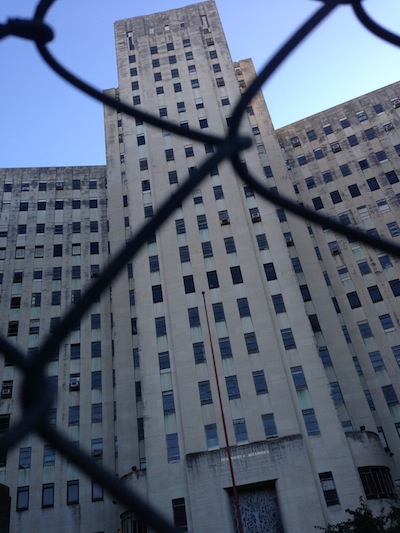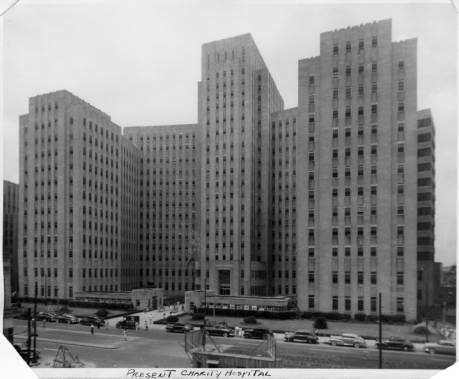Since Hurricane Katrina laid waste to the soaring Art Deco masterpiece, it seems like everyone and his uncle has come forward with a plan for the adaptive reuse of Charity Hospital. And yet eight years later it stands empty. The Lens is soliciting the views of our readers and city leaders. What do you think should be the building’s future?
Huey Long didn’t live to see Charity open as a high-rise hospital in downtown New Orleans. An assassin gunned down the governor-turned-U.S. senator four years before the first gurney rolled through the door, in 1939. But even without the Kingfish there to cut the ribbon, Charity, with its six offshoots around the state, was unarguably the capstone of Long’s sweeping vision of cracker socialism, a hospital for the ailing poor, a birthplace for paupers — some of whom, such as Ernie K-Doe, Donna Brazile and Ray Nagin, went on to become big shots, even mayors.
Today, Charity is a question mark looming over every scheme put forward to revitalize downtown New Orleans. It’s a towering monument to Katrina’s lasting impact.
In that fateful first week of September 2005, as patients were herded or wheeled across the street and coptered from an adjacent building’s rooftop landing pad, the assumption was that Charity would be reopened quickly as the hospital for the indigent it always had been. And if it got a technological upgrade at FEMA’s expense, well, that wouldn’t be such a bad thing.
But Tulane and Louisiana State University had bigger eyes than that. Their medical schools fed off Charity, and in disaster they saw an opportunity to escape the confines of a 65-year-old building and start from scratch — with a little help from friends in Washington.
They teamed up with the Veterans Administration, which also was interested in replacing its flooded hospital, alongside Charity. There would be economies of scale. Facilities like labs, a blood bank and food services could be shared.
This being Louisiana, things didn’t work out quite that way. The universities fell to fighting — with preservationists, with FEMA, with each other — and the VA set to work on a new hospital, with blood banks, labs, laundry and a food service all its own.
Even if the billion-dollar plan for new hospitals hadn’t meant bulldozing 40 blocks of vintage housing on the other side of the Claiborne overpass, preservationists were sure to bemoan abandonment of Big Charity. The building was and remains a masterpiece of the Art Deco style, designed by the firm responsible for another Art Deco triumph ordered up by Huey Long, the Louisiana State Capitol.
The universities were a jump ahead of their critics, however. They hastened to say that it would cost more to retrofit the flooded 1939 building than to build from scratch across Claiborne. Though just the basement had been flooded, they pointed out that was where the electrical and mechanical systems were located. Later, they tried scare tactics and switched to plan A — A for asbestos. The building was choked with the stuff, they argued.
A study commissioned by the Foundation for Historical Louisiana refuted those arguments, showing that Big Charity not only was suitable for a new medical facility, it would be faster and cheaper to put it there.*
Over the universities’ protests, the Army cleaned up Big Charity and declared it ready to reopen as a hospital. But the universities revved their bulldozers and headed across Claiborne, amid accusations they were engaged in a duplicitous campaign to defy the public will at a hugely inflated cost to taxpayers.
Ever since it became clear that Charity’s days as a hospital are over, a variety of schemes have been floated.
Mayor Mitch Landrieu is not the first to talk about moving City Hall over there. With much fanfare, Nagin had locked arms with a hotel developer and announced plans to turn Duncan Plaza and adjacent buildings into a cultural center.

The hotelier was delighted, of course, and city government would have had a good excuse to leave its increasingly dilapidated digs. Nagin cast an eye at Charity as a new City Hall before deciding instead to focus on the Chevron Building several blocks farther downtown — a scheme that, like most Nagin schemes, died aborning.
As a parting shot, Nagin muttered something about turning Charity into condos, apartments — some kind of housing for the nurses and interns and lab techs that the billion-dollar medical complex would need. Nothing came of it. Nor of the idea, briefly touted, that Charity might make a nifty nursing home.
The renewed interest in making Charity the center of city government has inspired collateral ideas. Because Charity is bigger than needed for city government and because its conversion would be pricey, at about $300 million, Landrieu has tried to sweet-talk Civil District Court judges into taking over a wing. The court, it so happens, generates a steady revenue stream that could be useful for floating bonds.
Motion denied — at least for now. They have come up with a fresh argument against relocating to Charity: the structural columns that hold up the floors. They’re too close together to provide galleries, juries, lawyers and the robed ones with an unobstructed view of one another.
Developer Pres Kabacoff, the latest to roll out a sweeping vision for downtown renewal, contends that the column issue can be overcome. And he’s got another idea for the part of Charity that City Hall doesn’t need: a neuroscience center. It would be nicely aligned with the hospitals that have vaulted the Claiborne overpass and are now taking shape alongside, they hope, labs and office space for the nascent biotech industry the city hopes to foster.
Condos, neuroscience center, city hall, courthouse, nursing home — or is there a way to reopen Charity as a clinic or the hospital it once was?
With so many ideas in play, The Lens wants to hear from readers, preservationists, developers, city leaders. What’s your vision for Charity? Describe it and explain why it’s a good one. We’ll post the more provocative and sensible responses. Try to keep your pitch to a few hundred words or less.
To get you thinking, The Lens will host a live chat here at 12:30 p.m Tuesday. You can also weigh in via Twitter and by leaving a voice message with the Listening Post NOLA.
Share your ideas
Post your ideas and comments during the live chat, Tuesday at 12:30 p.m.
Tweet with the hashtag #charityfuture.
Call the Listening Post NOLA hotline at (504) 224-5314 and leave a message.
Stop by one of the Listening Posts and record a message there:
-
HeadQuarters barbershop, 1101 N. Broad St. in Mid-City
-
Norman Mayer Library 3001 Gentilly Blvd. in Gentilly
Email a proposal by Oct. 16.
Live chat, Tuesday 12:30 p.m.
*Correction: This story incorrectly stated that the National Trust commissioned a study on the suitability of renovating Charity; it was commissioned by the Foundation for Historical Louisiana. (Oct. 7, 2013)


